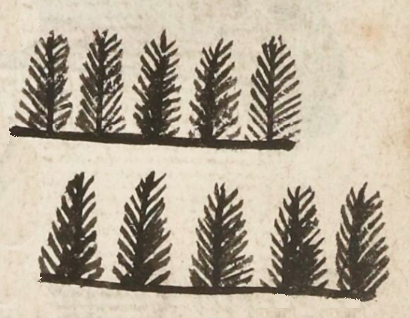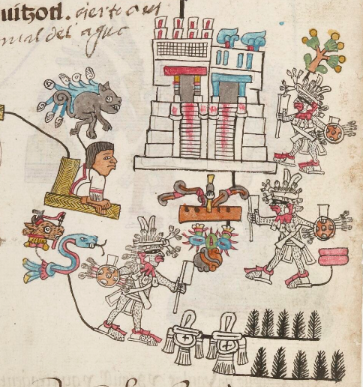matlactzontli (TR39r)
This is a black-line drawing of the simplex glyph and notation for the noun matlactzontli (4,000 or literally "ten 400's"). According to the gloss, the glyph is a tree branch, a thick trunk with lots of needles, no leaves, standing upright. There are two horizontal rows of five of these branches called tzontli, each row with a line connecting the items at their base. The lower row is not directly below the top row; it is offset a bit to the viewer's right.
Stephanie Wood
A century ago, 400 small pieces of firewood were bundled in what was called a tzontle, a Nahuatl loan in Spanish. (See: Paul Carpenter Standley, Trees and Shrubs of Mexico - Part 1, 1926, 806.) This may support the reading that this numeration called a tzontli could have an association with branches or trees. These branches ("ramitos" in the gloss) do look something like the laurel or pine branches (acxoyatl) that were part of religious rituals. Nigel Davies (Human Sacrifice, 1981, 218), in fact, called this tzontli sign a "fir tree." Zelia Nuttall (in a volume of anthropological papers called Boas Anniversary Volume, published by Berthold Laufer in 1906, 296) referred to the bundles of 400 as containing either "sticks" or "hair." Some of the tzontli glyphs in this collection do look like upright bundles of sticks that are bound around the middle. The example below from the Chavero Codex has a step design on the wrap that binds the sticks. A similar design on the binding appears in the Matrícula de Huexotzinco in a glyph for Tzompan.
Another common visual associated with the word tzontli involves large locks of hair or even strings of hair from the head. "Hair" is often the translation for tzontli into English. This word for hair and the word for 400 would therefore serve as homonyms. Similarly, speaking of 400 tzontles of corn cobs (Calixta Guiteras Holmes, Perils of the Soul, 1961, 47), is another case where the tzontli is simply a numeration and does not reflect upon the object being counted. So, the conclusion is that a sign for 400, like all of them, whether branches, sticks, or hair, will have the role of a phonogram.
Stephanie Wood
por cada rramito destos negritos quentan ençima dan a entender quatroçientos o numero de quatroçientos
por cada ramito de estos negritos cuentan encima, dan a entender cuatrocientos o [el] número de cuatrocientos
Stephanie Wood
ca. 1550–1563
Jeff Haskett-Wood
ten, 10, 400, four hundred, cuatrocientos, diez, cuatro mil, 4000, four thousand, árboles, ramas, ramitos, branches, contar, counting

matlac(tli), ten, https://nahuatl.wired-humanities.org/content/matlactli
tzon(tli), four hundred, https://nahuatl.wired-humanities.org/content/tzontli-0
Telleriano-Remensis Codex, folio 39 recto, MS Mexicain 385, Gallica digital collection, https://gallica.bnf.fr/ark:/12148/btv1b8458267s/f103.item.zoom
The non-commercial reuse of images from the Bibliothèque nationale de France is free as long as the user is in compliance with the legislation in force and provides the citation: “Source gallica.bnf.fr / Bibliothèque nationale de France” or “Source gallica.bnf.fr / BnF.”







